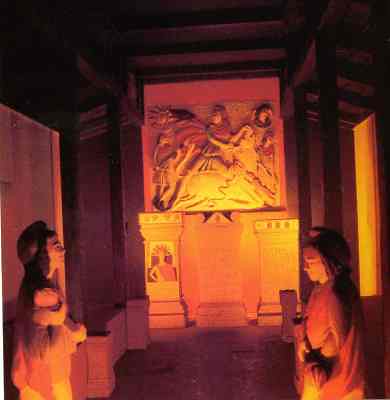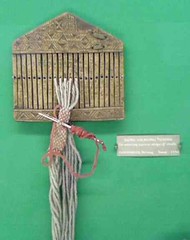After last night’s crash, and the trip to A&E (luckily I’m told it is almost impossible to break your sternum unless you’re very old and frail – which makes sense when you think about the stuff it is protecting…) I ventured jingerly into the centre of Newcastle on the rather misnamed Metro.
My slightly jaundiced view of the town wasn’t improved by the difficulty of finding directions to the Museum of Antiquities. The first couple of railway staff looked at me like I was speaking Japanese and of three people at the tourist office booth only one knew what I was talking about, a fact of which he was inordinately proud. (Should you need to ask for directions asking for the University of Newcastle might prove more effective.)
It was, however, worth the hunt. Although of the old and traditional form, it is a very nice collection. Centre-stage is a complete scale model of the wall and surrounding topography – impossible to photograph, but providing an excellent sense of where I’d been.
Its one piece of (rather antique) bells and whistles is a reconstruction of a temple of Mithras (20p in the slot), with commentary and flickering “candles”. The image below is taken from the excellent Mithras and His Temples on the Wall pamphlet.

The (reproduction) relief shown there was found in all Mithraeums, known as the tauroctony, showing Mithras slaying a primaeval bull that was the first living creature created by Ormzad (equated with Jupiter by the Romans, but not anyway important in the religion, curiously). This released the concentrated power of the animal for the benefit of mankind. (It was not, however, an act that could be repeated, so bulls weren’t sacrificed in the religion.
The figures in the foreground are Mithras’s two torchbearing supporters, Cautes and Cautopates, which also representating the rising and setting suns, hope and despair.
(Which reminds me to note that London’s mithraeum is on the move…)
 There are also some great sculptures, altars, and tombstones, including another of those terribly plaintive children’s markers. Also lots of excellent little archaeological items, including this nifty little tool for weaving small strips of material, displayed complete with demonstration.
There are also some great sculptures, altars, and tombstones, including another of those terribly plaintive children’s markers. Also lots of excellent little archaeological items, including this nifty little tool for weaving small strips of material, displayed complete with demonstration.
Then I went through for a stroll through the centre of town (generic high street) to Bessie Surtees house a miraculously surviving 16th and 17th-century grand merchants house, wiith some wonderful internal woodwork and fireplaces. (Even if it is hard to know how much os this is early 20th-century restoration and compliation of surviving elements from other homes.)
The sort of romance that would have captivated the Victorians probably helped the house survive, for the name comes from the said Bessie, daughter of a wealthy merchant, Aubone, who fell in love with the John Scott, son of a hostman (coal merchant). Her parents were not impressed, however, and on 18 Novemeber 1772 she fled, with the help of a servant, from a first-floor window and the young couple made a quick trip to the conveniently located Gretna Green, where with the help of a couple of “professional witnesses” they were married. But it all ended happily – the two sets of parents decided to live with a fait accompli and there was another “official” ceremony in Newcastle, and young John, as Lord Eldon, went on to be Lord Chancellor of England. (Although a rather curious caption noted that she “was never a very good hostess” and declined to hold many parties for him.)
Reading on the GNER train home (which was considerably better ventilated than the Virgin on the way up) was appropriately medieval/early modern Northumbria, including the tale of Lady Jane Delaval of Seaton Delaval, who had nine sons and eleven daughters. “Free at last after her sanctimonious husband’s death in 1628, Lady Jane ran off with his secretary.” (p. 68)
Perhaps understandably the local women might have been getting sick of attending births, for a local court had ordered in 1592 that “within Seton Delavale and Hartlowe [Hartley] … every mann’s wife within this lordship shall, within half ane howre after warning, presentlie repaire and go to every woman laboring of child, if they be thereto called and invited, sub pena xijd”. (p. 73)
Sir William Fenwick of Meldon was during the reign of James I thought to be a church papist. He was paying recusancy fines for his widowed mother, Meg of Meldon “commonly regarded as a witch”. (p. 83)
From: Watts, SJ, From Border to Middle Shire: Northumberland 1586-1625 (1975)
****
So there’s the tale of a week of cycling, my first. A few practical notes:
*Anyone with even a very moderate degree of fitness could do this. Had I not been felled by the cold I think I would have found it easier than I expected – you do get into a rhythm, and the difference from doing CTC rides in London in groups is that you can set your own pace.
* Next time I might try for the minimal luggage, carry-it-myself approach, chiefly because it would be quite nice to be able to just work out your route as you went, so say the cold wouldn’t have been such a problem.
* Advice to buy a pair of specialist padded cycling shorts proved extremely worthwhile. (Thanks Marion!) Definitely worth £20 on eBay. (But don’t worry, I always covered them up with either cycling trousers or baggy ight cotton shorts – don’t want to scare the horses.)
* It takes me 30 mins to an hour (depending on terrain) to get across two folds of an Ordinance Survey map, and a clear plastic map-holder that fits on the handlebars is an extremely worthwhile item. (On my eBay list…)
* What is a little tricky is combining the cycling and sightseeing. It is hard to just hop between the two; once you’ve got started you tend to want to keep going. For me a good pattern is morning sightseeing first-thing, a couple of hours of riding, lunch, leisurely sightseeing, then a couple more hours of riding. That will easily fit in c. 30-35 miles of travel a day. On reasonably flat ground that’s about right. (I have my eye on Norfolk … really not a fan of hills.)

 About
About
7 Comments